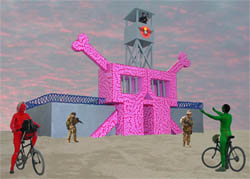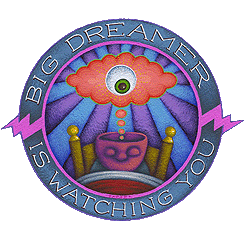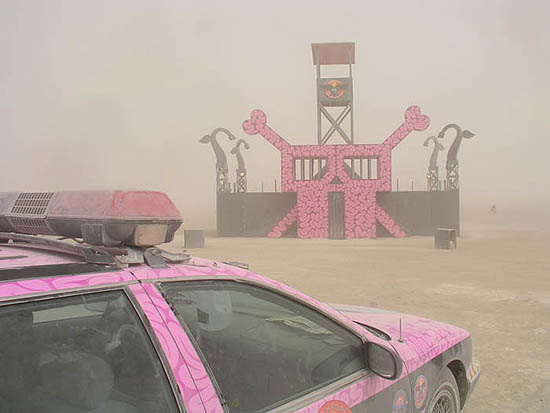| |
|
|
| |
CHECKPOINT DREAMYOURTOPIA
- A Border Control Checkpoint to Enter Your Own
Dreams -
|
The American Dream From a Foreigners View |
 "Looking at the American
Dream theme as the foreigner that I am, my starting
point was the fact that for millions of people around
the world the American Dream still exists, but it is
becoming more and more impossible to achieve because of
increasingly fierce border controls, visa regulations,
etc. All of them are trying to cross the border in order
to chase the rainbow in search of the eternal pot of
gold. (Of course this is becoming a universal phenomenon
in our global age, as more and more people around the
world are trying to enter their promised land , trying
to out clever the border patrols at the Mexican border,
or embarking with way too many people on an uncertain
dangerous journey in small boats trying to reach the
European shores from Africa.) "Looking at the American
Dream theme as the foreigner that I am, my starting
point was the fact that for millions of people around
the world the American Dream still exists, but it is
becoming more and more impossible to achieve because of
increasingly fierce border controls, visa regulations,
etc. All of them are trying to cross the border in order
to chase the rainbow in search of the eternal pot of
gold. (Of course this is becoming a universal phenomenon
in our global age, as more and more people around the
world are trying to enter their promised land , trying
to out clever the border patrols at the Mexican border,
or embarking with way too many people on an uncertain
dangerous journey in small boats trying to reach the
European shores from Africa.)
 For some, it is an opportunity to achieve more
prosperity than they could in their countries of origin;
for others, it is an opportunity for their children to
grow up with an education and career opportunities; for
still others, it is an opportunity to be an individual
without the constraints imposed by class, caste, race,
gender or ethnicity. People might work harder and longer
hours to get bigger cars, fancier homes and other fruits
of prosperity for their families, leaving them with less
time to enjoy their prosperity. Others may look toward a
new American Dream with less focus on financial gain and
more emphasis on living a fulfilling and fun life. For some, it is an opportunity to achieve more
prosperity than they could in their countries of origin;
for others, it is an opportunity for their children to
grow up with an education and career opportunities; for
still others, it is an opportunity to be an individual
without the constraints imposed by class, caste, race,
gender or ethnicity. People might work harder and longer
hours to get bigger cars, fancier homes and other fruits
of prosperity for their families, leaving them with less
time to enjoy their prosperity. Others may look toward a
new American Dream with less focus on financial gain and
more emphasis on living a fulfilling and fun life.
This emphasis on the individuals dream became my focus
in this new project:
A Border Control Checkpoint to enter your own Dreams
Thus it might make you realize that not only crossing
the real borders between countries to enrich your life
in whatever sense can be a difficult task. Also crossing
the boundaries inside the system of your own heart and
life might mean a big leap into the unknown, full of
dangers as well as pleasures." -
Dadara, Amsterdam, January
2008 |
|
| |
|
|
| |
 |
|
| |
|
|
| |
Playing at Bare Life: Dadara, the
State, and Homo Sacer
By Charissa N. Terranova , Professor of Aesthetic
Studies at UT Dallas and Director of the Centraltrak
Artists Residency - From the 14+1 blog : 14 Minutes of
Fame and 1 to keep -
http://fourteenplusone.org
It does not matter…that the killing of homo sacer can be
considered less than homicide, and the killing of the
sovereign as more than homicide; what is essential is
that in neither case does the killing of a man
constitute an offense of homicide. Giorgio Agamben[1]
In between, within, and without Dadara’s Checkpoint
Dreamyourtopia, there is the body of homo sacer: the
bare life of the border crosser, non-citizen, refugee,
prisoner, torture victim, death row inmate, other and
dialectical necessity of the full-fledged citizen. In
contrast to man as citizen, we have before us man as
bare life: that which can be spent with impunity – life
extinguished without homicide because it is deemed
outside of the law and thus without value. Built in
Dallas and installed and performed at Burning Man in
Nevada 2008, Checkpoint Dreamyourtopia is a human-scaled
game board at Centraltrak that calls upon art lovers and
fun seekers, interpolating them into role-playing
ventures. In nuce, the script goes something like this:
“Hey you! You there…immigrant, I am guard, not
alien-other, and you are not guard. I am subject and you
are object.”[2] We the people become we the players,
sometimes alien andhomo sacer, sometimes guard and legal
citizen, but all crossing the borders of identity
inherited by pre-given structures.
Put simply, Checkpoint Dreamyourtopia challenges the
idea and reality of the borders of your country and your
heart. It is an ersatz border-themed work of interactive
performance art. Upon completion of mandatory
immigration forms and interrogation by guards, visitors
are given official Dream Yourtopia passports and money
and allowed entrance into a world of personal dreams. It
is a work about the imagined experience and ideal of the
“American dream,” the concept, myth and reality of which
is known the world over, by Americans and internationals
alike. Essential to this potent and guiding mythology is
a process of national border crossing — passage through
major portals, such as Ellis Island — assimilation, and
hard work. As much as “We hold these truths to be
self-evident, that all men are created equal” is
fundamental to our national law and psyche, so too are
the words “Give us your tired, your poor, your hungry,
your huddled masses yearning to be free,” the sentence
carved on the Statue of Liberty which historically
greeted immigrants in search of The American Dream in
the 19th and early 20th centuries. The American Dream is
increasingly difficult to realize because of evermore
fierce border controls and visa regulations. “Checkpoint
Dreamyourtopia” riffs on this difficulty, in particular
as it is manifested in the challenges to border crossing
in an age of fear, terror, and asymmetrical war waged by
both developed and undeveloped countries.
The project extracts the two-fold theme of
“individualism” and “personal grit” from the mythology
of The American Dream and re-channels it into the
psychological space of pleasure and desire. Entrants
with the proper paper work pass through a border control
checkpoint and enter the world of their own dreams,
instead of The American Dream. The project parallels
real borders between countries and the boundaries inside
the structures of your own heart, revealing their
similarities — that both trigger a big leap into the
unknown, life full of violence, danger, pleasures of
jouissance, whatever they may be.
Dadara’s borderland project
is unique in its combination of theatricality,
participatory performance, conceptualism, temporality,
and architecture. It unfolds in time not so much as a
narrative but as technocratic process. The goal here is
to rarefy experience not singly as an object but as
bureaucratic movement and negotiation through time.
Objectification comes by way of personhood and
architecture: upon acceptance or rejection by guards
playing at bare life in a border patrol building, an
architectural mise-en-scène mimicking official state
apparatuses, one assumes their subjecthood as citizen or
homo sacer. You are either in or out, and being “in” is
far more physically comfortable than being “out.” In
this setting, the body is at base a barometer of pain
and pleasure, the locus of a performative take on Locke
and Bentham’s felicific calculus (the greatest good is
the happiness of the many), which, in turn, is catalyst
for quasi-bureaucratic practice, or what we have come to
know as “modern democracy.” Disconnected objects give
way to action in space, thinking, dialogue, and critical
awareness of the structures, legal and otherwise, in
which we perform – or are allowed to perform – as
individuals. Checkpoint Dreamyourtopia fits within a
taxonomy of guided experiences set in motion by
sociologists, corrupt administrations, and architects in
pursuit of a deliberative guffaw. Related projects
include a sociological prison experiment at Stanford
University in 1971, dastardly war crimes of torture at
Abu Ghraib, 2003-2004, in Iraq, and
conceptual-architectural design antics by contemporary
Dutch design firms, 1990s-present.
A SHORT SHORT TAXONOMY OF BARE LIFE IN THE POST WWII
PERIOD [AS AUSCHWITZ IS THE ÜR CAMP OF BARE LIFE] -
Checkpoint Dreamyourtopia, Dadara, Nevada/Dallas,
2008-2009. In April 2008, Dadara presented a maquette of
the border patrol precinct realized below in the deserts
of Nevada in September 2008. Brought to Dallas in
January 2009, the full project mirrors bureaucracy at
the scale of the nation-state and includes ersatz
immigration documents, passports, money, a police car,
border patrol building, guards with fatigues, and you,
the would be citizen or alien reject.
Stanford Prison Experiment, Conducted by Psychology
Professor Philip Zimbardo at Stanford University, 1971.
In 1971, a team of researchers led by Psychology
Professor Philip Zimbardo selected twenty-four graduate
students, half of which would play the role of guard and
half of which the role of prisoner. Zimbardo and team
created a mock prison in the basement of the Stanford
University psychology building. Roles were assigned
arbitrarily to all students who were chosen on the basis
of their clean bill of health, i.e. lack of
psychological issues. The experiment was intended to
last for two weeks, but was terminated after six days
because of the extreme nature of role-playing and
identity adaptation that ensued. Several guards were
judged genuinely sadistic, while prisoners were overcome
by trauma.
Abu Ghraib Torture and Prisoner Abuse, American Soldiers
and Iraqi Citizens, Abu Ghraib Prison Facility, Iraq,
2003-2004. In February 2004, Major General Antonio M.
Taguba completed a 53-page report on the institutional
failures of the Army prison system in Iraq, describing
incidences of “sadistic, blatant and wanton criminal
abuses” at Abu Ghraib, the military prison located in
the Sunni Triangle. Abuses included breaking chemical
lights and pouring phosphoric liquid on detainees;
pouring cold water on naked detainees; beating detainees
with a broom handle and chair; threatening male
detainees with rape; allowing a military police guard to
stitch the wound of a detainee who was injured after
being slammed against the wall in his cell; sodomizing a
detainee with a chemical light and perhaps a broom
stick; and using military working dogs to frighten and
intimidate detainees with threats of attack and one
instance of actually biting a detainee.[3] In the 2007
book The Lucifer Effect: Understanding How Good People
Turn Evil, Stanford Psychology Professor Philip Zimbardo
parallels the Prison Experiment of 1971 and the torture
at Abu Ghraib in 2003-4 by way of the fundamental
question concerning the nature of human nature: “How is
it possible for ordinary, average, even good people to
become perpetrators of evil?”
The Disciplinator, 2003, The Technocrat, 2003, Slave
City, 2005, Atelier Van Lieshout, Rotterdam, The
Netherlands. Since the 1990s the Dutch design firm
Atelier Van Lieshout, founded by Joep van Lieshout, has
been making work that centers on the dyadic play between
homo sacer and citizen, bare life and the good life of
the public sphere. Like the work of Dadara, this work
begins with an idea in the form of a drawing and grows
from there, becoming bigger in format, three-dimensional
and life size, and finally a mise-en-scène for
performance of the interchange between citizen and
non-citizen, member of the city and drone of the camp.
Pig City, MVRDV, 2001, Rotterdam, The Netherlands. In
2001, the Dutch architecture firm came up with Pig City,
a visionary project engaging ecological consciousness
and the bare life of animals. It is a computer simulated
coastal environment in which pig farming occurs
vertically in towers instead of horizontally in big
boxes. In moving the production of pig life upward
instead of outward, the architects at MVRDV sought to
push density up into the sky, freeing up the ground in
order to subvert soil erosion. In the process of
bringing home an idea of ecologically sound pig farming,
MVRDV reinforces the devalued role of animals in the
processing and manufacturing of life. The industrial
farming of animals – pigs, chickens and cows – for human
consumption can only happen in an ideological structure
where humans view animals as soulless raw material, akin
to rubber, petrol, and wood. Eat up! Yum.
IN CONLUSION - So, if I may indulge in a rather
tasteless allusion to Agamben’s homo sacer, I can risk
the claim that the predominant liberal mode of
subjectivity today is Homo sucker: while he tries to
exploit and manipulate others, he ends up being the
ultimate sucker himself. Slavoj Zizek[4]
In Checkpoint Dreamyourtopia, Dadara plays with bare
life, showing it to be the necessary footing of
full-blown citizenship. The anonymous artist of Dadara
nimbly facilitates a game of power, or what the Italian
philosopher Giorgio Agamben describes in terms of the
opposing forces of “nature and culture, zoeand bios.”[5]
Made aware of this common under-footing, namely that the
devalued non-citizen isl’homme at the core of the
citizen, le citoyen, are we all the better, ready to
avoid the travails of torture and murder with impunity?
Not necessarily. As long as we live in a state where
execution is legal, knowing is but a pallid beginning,
rote pulsion towards the ineffable negotiation of the
tides of subjecthood and the state. The Slovenian
philosopher Slavoj Zizek forewarns of becoming “Homo
sucker,” smug in our self-assuredness of who is
committing crimes. There is culpability in all corners,
left and right, but is there a way out? To query this is
to yearn for metaphysics on the sly. |
|
| |
[1] Agamben,
Giorgio, Homo Sacer: Sovereign Power and Bare Life,
trans. Daniel Heller-Roazen (Stanford, CA: Stanford
University Press, 1998) 102.
[2] Althusser, Louis, “Ideology and Ideological State
Apparatuses: Notes Towards an Investigation,”Lenin and
Philosophy, trans. Ben Brewster (London: New Left Books,
1971) 127-86.
[3] Hersh, Seymour M., “Torture at Abu Ghraib,” The New
Yorker, May 10,
2004,http://www.newyorker.com/archive/2004/05/10/040510fa_fact
[4] Zizek, Slavoj, Welcome to the Desert of the Real:
Five Essays on September 11 and Related Dates(New York:
Verso, 2002) 71.
[5] Agamben, 181. |
|
| |
|
|
| |
 |
|
| |
|
|
|
|
